|
LiveScience Senior Writer
NEW YORK A drawing of a colorful tree, with the Medicine Buddha wedged above its leaves, seems more art than medicine.
But this whimsical diagram provided guidance for Tibetan doctors more than 300 years ago. Its branches and leaves illustrate the humors - bile, wind, phlegm - believed to determine bodily functions and how and where disease can arise. Flowers atop this tree produce two berries that represent not only material health but also spiritual well-being and liberation associated with the attainment of bliss, the caption explains.
However,
While Western medicine counts only 206 bones in an adult, 360 distinct bones are precisely enumerated in this front view of the human skeleton (plus the back view, not shown). Bones and their articulations are important in Tibetan medicine not just for their role in structuring the body but also because they form part of the pathway or channel through which the life essence flows. Catalog #70.3/5470 Courtesy, Division of Anthropology, AMNH
Monks from the Tashi Lhunpo monastery performed an opening ceremony at the American Museum of Natural History the day the exhibit opened. As part of that, they chanted and played instruments in the gallery with the paintings. Credit: Wynne Parry
Returning to health meant restoring balance among the humors, and, as another tree diagram shows, a Tibetan doctor had three tools at his disposal when investigating an imbalance: observation, touch and interviews with the patient.
Other charts, with precise illustrations, explain prognoses offered by omens and dreams. There are also charts for pulse and urine analysis, anatomy and treatments. These colorful, detailed images are actually copies of copies.
The Nepalese artist Romio Shrestha and his students created them by copying older paintings likely made in the early 1900s. (The complete set has 79 paintings, not all are being displayed.)
These, in turn, were based on the originals, which were painted sometime between 1687 and 1703 as illustrations to a commentary on a classic medical text called "Four Tantras."
The paintings were originally commissioned as teaching aids for a medical school in Lhasa, Tibet.
The paintings on display are not exact
copies of the replicas from which Shrestha worked, but were made
with a different awareness and different materials, and contain more
detail and color, Shrestha said.
Here they played instruments and chanted
in guttural voices; then, in a procession trailed by journalists and
museum-goers, they traveled up two floors, through numerous
galleries to the medical paintings exhibit, where the ceremony
continued.
This particular
one would be dedicated to healing, and the monks would work on it
for the length of their stay, destroying the design at the end of
their visit, as an acknowledgement of impermanence of existence.
(Schedule
for the Monks' Visit)
Like a GPS, a mandala - the designs for which were taught by Buddha - contains the data for a journey of exploration. (Why Are Monks So Darn Happy?)
|


